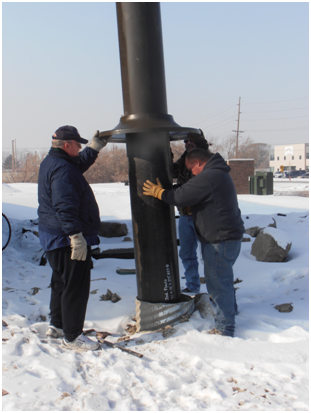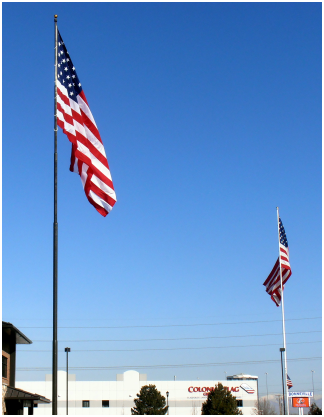Raising a Big Flagpole and Flag Earns a Big Salute

A huge crane lifts the new flagpole for Challenger School’s offices into position.
Travelers driving on Interstate 15 through Sandy City in northern Utah see a huge U.S. flag flying at Colonial Flag Company near the 90th South freeway exit. Although many who travel the route daily may have become accustomed to the scene, it is an image hard to miss. While flags and poles come in many sizes, outdoor flags usually range in size from 3’ X 5’ for a twenty foot flagpole to a flag measuring 8’ X 12’ for a forty foot pole. How big is Colonial’s flag? At 30’ x 60’ the flag is certainly bigger that anyone could fly at home. Few companies fly flags that approach that large size. Now then, how big a flagpole is needed to fly such a large flag? Well, the flagpole in front of Colonial Flag’s building is a whopping 120 feet tall, that is 120 feet above ground and another 12 feet buried in the ground as an anchor.
Now Colonial’s huge flag and pole have found a twin right next door. Challenger Schools when constructing their new offices at the corner of 9400 South and Third West ordered a flag and pole equal in size to the flag and pole marking Colonial Flag Company’s own offices and showroom. So, travelers passing 94th South on I-15 will now see not one but two huge flags flying from two tall flagpoles.
The installation of Challenger School’s huge flag and pole gave employees at both businesses the rare opportunity to watch the new flagpole being moved into place. The tapered black steel flagpole measured 132 feet in total length as it laid on the ground when the spectators formed to watch. Workers had already sunk a twelve foot steel tube into the ground ready to accept the bottom twelve feet of the pole and to anchor it in place, but how do you maneuver a pole of that length into the prepared metal sleeve?
A crane, a big crane tall enough and strong enough is required to do the job. A sling is fastened to the pole and it is lifted vertical until its base is several feet above the ground, and then as the crane’s boom smoothly swings, the base is positioned directly above the metal sleeve. The metal flashing or cover is fitted on the bottom of the pole so it can be slid up the pole to be in position for later adjustment. The procedure requires strict compliance with rules of safety, and there is no room for carelessness. Then the pole is lowered slowly until its lower twelve feet disappear into the ground. The pole is adjusted vertically until it is plumb and rises straight up. When everything is perfectly oriented, sand is poured into the steel tube where the pole’s base has come to rest. It takes many fifty pound bags of sand to fill the empty space in the twelve foot tube surrounding the pole. As the sand settles, more sand will be added and the flashing threaded on the pole earlier can be lowered to cover the connection of flagpole to ground.

Workers carefully lower the new flagpole into the twelve foot metal sleeve buried in the ground.
While the procedure did not take that long, it was an exciting experience. Further it culminated an effort to construct a specially ordered flag and pole as neither are standard items found in a catalog. The 30’ X 60’ U.S. flag that flies on the Challenger School’s beautiful new flagpole was sewn in the building next door. Those working at and visiting the school’s headquarters can take pride in their impressive new flag and flagpole. Still, Colonial Flag’s employees—seeing the twin of their own flag and pole—have the added satisfaction that their work made this imposing sight possible. They know further that accomplishing this, Colonial Flag Company’s team can accomplish smaller challenges in stride. Customers can have confidence that Colonial Flag experts will fill their orders for flags and flagpoles and insure that everything is done right.

Two huge flags and tall poles now greet travelers along Interstate 15 where before one stood alone.
